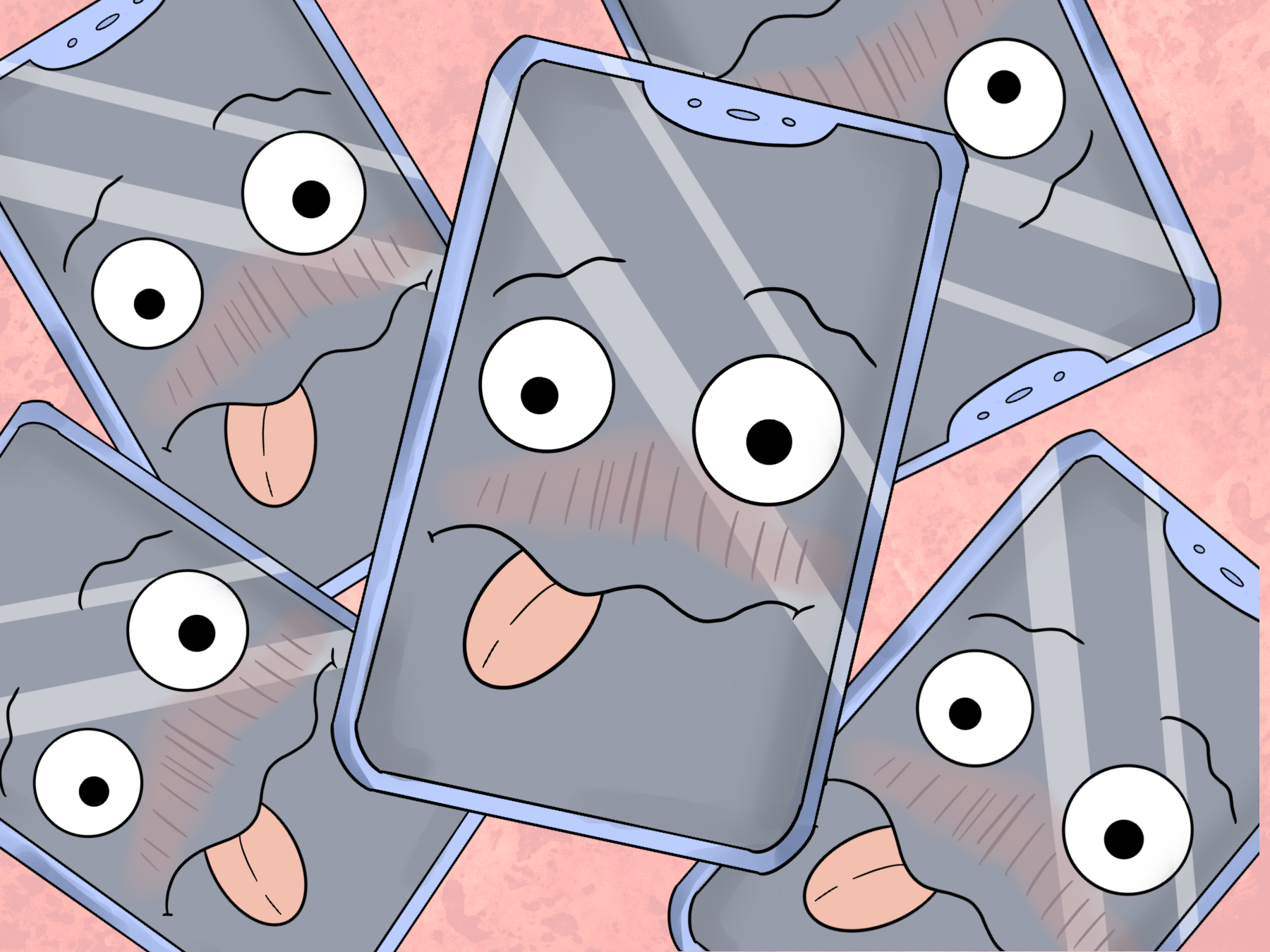Smeared screens, filthy phones and dirty devices. It has been years since phones just called or texted; they also forecast the weather, act as GPS devices and do practically anything else you need them to do. With the daily necessity of smartphones, our devices go everywhere we go, including the bathroom, the bank and public parks. As a result, WebMD-proficient researchers have ripe opportunities to learn about the cesspool of germs that procreate on the glass screens of their phones.
Microscopic germs are not the only health hazard that smartphones present, however. They also significantly affect mental health and can even cause long-term eye damage. When it comes to smartphone use, health is more complex than something that can be fixed with a simple Clorox wipe.
Protecting Hands
It begins when one tabletop germ flirts with a drinking glass germ from across the room and they slowly build up hope that they will one day meet. One person slowly makes their way over to a table and sets their fingertips on the tabletop. One germ picked up, one more to go. Eventually, the person walks to the drink table and selects a glass that happens to carry the other flirtatious germ.
Huzzah! The germs can now reproduce at alarming and undetectable rates.
So what do we do? We look at our phones in disgust and then wipe the screens with the bottom of our shirts, as if that will adequately disinfect them.
Tiny brand new hands, wrinkly hands and busy hands usually all have one thing in common: All three typically have access to smart devices, which are the dirtiest things most people touch.
One might think, “So, a baby plays on a dirty iPad. They do that all of the time and they have seemed fine so far. Sure, it is possible that as they get older they might try things like eating Tide Pods or walking on stacks of milk crates for the internet. But, to be fair, they probably would have done that anyway, iPad germs or not.”
According to a study by researchers at the University of Arizona, cell phones are 10 times more infested with bacteria than the average toilet. Yes, 10 times more.
“Taking a cell phone into the bathroom and then leaving with it is kind of like going in, not washing your hands and then coming back out,” says Emily Martin, assistant professor of epidemiology at the University of Michigan School of Public Health.
Effective cleaning procedures start with one making an effort to not haul their phone into the bathroom with them. It is tempting. You have not checked Instagram all day. You got a notification that your favorite YouTuber just uploaded a new video. You got an important email. Still, Martin says it can wait until your hands are clean and you have exited the lavatory.
Here is a recipe for your very own cell phone sanitizer.
Ingredients:
- 60% water
- 40% rubbing alcohol
Instructions:
- Stir ingredients
- Dip a cotton ball, rag or cloth into the concoction
- Use rag to gently clean the contaminated surfaces of the phone
Protecting Eyes
In this case, “seeing blue” is not a sign of sadness, although it may make one sad. Blue light radiates from the screens of electronic devices and has the potential to cause many kinds of diseases and discomforts.
Chances are, if you are like many young adults in the Western world, your weekly screen time reports are not something that you are proud of or show off to family. Whether you rack up two hours a day or you spend 11 hours on your phone every day, blue light has access to a regular feed into your eyes.
Blue light can cause sleep problems, blurry vision, dry eye, macular degeneration and cataracts. In the long term, blue light can also affect one’s retinas, causing phototoxicity.
This may sound hopeless if you do not know about the available solutions but, fortunately, they do exist.
Instead of prescribing medication or a special diet, scientists recommend regularly giving your eyes a break by looking away from the screen, as well as investing in blue light glasses. These glasses have yellow-tinted lenses so they can soften the blue light’s blow on one’s eyes.
Even if you are someone with naturally blue eyes, protecting your retinas from the intense UV rays on your screen is crucial for lasting eye health.
Protecting Minds
Finally, one of, if not the most important element of electronic health, is its impact on mental health. Scrolling through social media in a mindless daze because it is a habit, or immediately picking up your phone to pretend to text someone when you are in a social setting, are both signs of an unhealthy attachment to one’s phone.
The Pew Research Center reported that those who use social media regularly experience higher levels of anxiety and depression — and in the United States, 69% of adults and 81% of teens use social media on a regular basis.
While social media usually gets the spotlight in discussions about the harm of technology, it is not the only culprit.
Similar data from the Pew Research Center pointed to the fact that excessive use of smartphones can impact sleeping patterns as well as cause an addiction of sorts. A German study published in 2017 gave evidence that using social media and smartphones mirrors the experience of using a slot machine in a casino. When you open your phone, there is always a chance that a life-changing text awaits you. Or perhaps your best friend just posted a photo of themselves online. Or maybe you will find an email with updates on what college you got into. There are infinite possibilities as to what you will find when you “pull the lever” and discover what notifications you will find.
This may seem like an innocent addiction, especially since most people in the U.S. have it. However, pointing back to the previously mentioned increase in anxiety and depression, it is clear that there are significant negative impacts derived from the compulsive need to check one’s phone every three seconds.
Solutions for this problem vary. Some young adults choose to purge themselves of their temptations and invest in a simple flip phone that only takes calls. This way they can escape smartphone addiction. Others choose to turn notifications off of certain apps like Instagram so they are not regularly reminded to check their phones. Some schedule times when they are allowed to be on their phones.
Each person may need a unique response to their own smartphone addiction. However, those who make an effort to have a holistically healthy relationship with their smartphones, whether it comes to external germs, blue light or mental health, may find that they are healthier people overall.
















